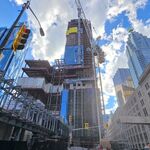It's not about which side of the 416/905 border you live on but on how easily accessible transit is.
Well said. It's amazing that anyone could claim otherwise when the Yonge subway is at capacity because of trips beginning in 905; GO trains are full from 905 to downtown every weekday, and even an embryonic system like DRT has recorded a 20% increase in ridership since the beginning of the year.
Obviously, there are some 905ers who are wedded to their car and would not switch for anything, but that is equally so in Toronto - although I'm more than prepared to grant that the ratio of such people is higher in 905.
The core issue is providing a transit service that is cost-comparable with car travel (preferably less expensive, which is certainly true of the downtown-oriented services I'm mentioned once one factors in parking downtown) and travel time (again true for downtown trips). Waiting time can be a factor as well as overall convenience issues (car: can make stop offs along way; transit: can read or sleep instead of driving), but those are addons to the core issues of service availability, speed, and cost. People will wait (but only to a point) for the right service, and making the wrong service frequent will accomplish little.
The problem is that we have all too few of the right services. Crowded local transit on city streets is NOT attractive to anyone can afford a car and is not committed to the idea of using transit. In 905, local service is all too often a joke - my local route in Ajax runs every half hour during rush hour, and that's it. Off peak, I either have a thirty minute walk to another route or (evenings and Sundays) I retain local service on my street in the form of a circuitous "combined" route (e.g. three routes lumped together) operating on an hourly schedule that is unattractive for anyone who has a choice.
So we need a mixture of things - better long distance and medium distance services (and the GO REX proposes that Metrolinx has been talking about, and which appear to be coming to the RTP in the form of 15-minute service freuqencies) will be very important) as well as substantially improved local service. We need to treat the rider as a customer to be attracted, not as someone that we have to provide the cheapest possible service for. And yes, the services need to be on dedicated ROWs/lanes as much as possible, and the service frequencies need to be better.
We need a lot of things, in short - and it's going to take time to get all of them. With luck, we can at least make a start on it and hope that gas prices continue to keep pressure on our politicians.




